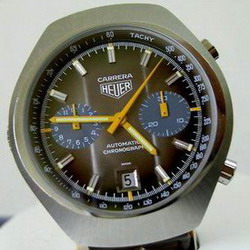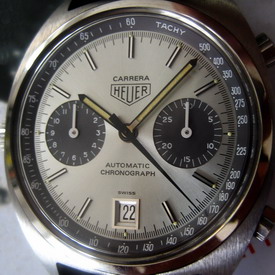| Informational Websites | ChronoMaddox -- the legacy of Chuck Maddox | OnTheDash -- vintage Heuer website | Zowie -- Omega information |
| Discussion Forums | ChronoMaddox Forum | Heuer Forum | Omega Forum |
| Counterfeit Watchers | ChronoTools Forum | ChronoTrader Forum |
|
|
The largest independent, non-commercial, consumer-oriented resource on the Internet for owners, collectors and enthusiasts of fine wristwatches. Online since 1998. | |||||||
|
||||||||
|
||||||||
 |
Vintage Heuer Discussion Forum
The place for discussing 1930-1985 Heuer wristwatches, chronographs and dash-mounted timepieces. Online since May 2003. | ||||||
| |||||||
| |||||||
The mid-70s continued
I left off yesterday with the 4- and 5-digit reference numbers pretty well understood, but with a lot of questions about how the 6-digit references are formed. It suddenly occurred to me that one of my assumptions based on the 4 digit schema was incorrect for the 6 digit and it was all as clear as day. One of those “why didn’t I see it before” moments but hindsight is always like that.
Let’s pick up again with the 5-digit references for the Monacos released in 1974 using the Valjoux 7740 movements. These still conform to the XXXYZ schema we looked at before for the Vj 773x movement family. The first number is removed from the reference as unnecessary, as it is always 7 and omitting it doesn’t cause any confusion. We can’t say the same for the second 7 – although always present too, if it was omitted and an XXYZ schema as per the automatics was used, you would have some references that were quite close to the Autavia and Carrera 45s from the 60s.
So a manual Monaco in steel using the Vj 7740 movement takes a reference 74033.
.jpg)
.jpg)
A 5 digit schema allows for an unambiguous model reference for the Carreras and Monacos, but less so for the Autavia as we saw last time when the 11630 was introduced. It is this difference in case that necessitates the two different references, 1163 and 11630 and this provides us with a big clue as to how the 6 digit references work.
I had been assuming that the model line reference (e.g. 3 for Monaco, 5 for Carrera etc) would be carried over intact from the 4 and 5 digit schemas to the 6 digit. My focus on Carreras probably didn’t help here, as the Carrera identifier (5) did indeed appear in the reference for the 3rd generation “barrel” Carrera e.g. 110.573 F and the late model 2nd generation Carrera e.g. 110.253 G. But I had no explanation for why the 5 appeared in a different position in each reference.


The amended reference for the Autavia 11630 that didn’t fit into the previous schemas was key. It meant for the first time that a reference didn’t uniquely resolve to a specific model in a specific case. The situation would also shortly be the same for Carreras, with barrel cased 3rd generation models being sold alongside 2nd generation models. A single model line reference wouldn’t cut it and now it becomes clear.
The six digit schema includes a case reference. Of two digits. Sometimes this resolves to a single model line, sometimes model lines share a case reference (giving rise to the confusion between late Pasadenas and Montreals we saw earlier) and sometimes a model line has more than one case type (e.g. barrel and 2nd generation Carreras). One place this case reference is clear is when comparing late 2nd generation Carreras with the 4th generation. They use the same case, as is shown by their respective reference numbers – 110.253 and 371.253, the key digits being in the 4th and 5th positions.

So the 6 digit references take the format:
XXX.YYZ
Where XXX are significant digits from the movement (right packed if necessary), YY indicates the case/model and Z again indicates the case material.
Now, this isn’t foolproof. One specific case number appears to be used for “miscellaneous” as it crops up on a number of otherwise unrelated watches. Also, when the divers come along, they use a 6 digit schema all of their own, with the last 3 digits simply increasing to signify a different model. The late PVD and gold-plate Autavias largely conform to this, but the right-most digit for the movement is incremented to show different case finishes. At this point, Heuer was in different ownership, so corporate standards may have changed or not been adhered to as closely.
To add to the confusion, Heuer didn’t adopt this new schema for all the existing watches, so we have a number of them in operation at once:
- the 4 digit schema for automatics
- the 5 digit schema for manuals
- the 5 digit Autavia schema, amended from the 4 digit
- the 6 digit schema
- the 6 digit divers schema
- and a number of orphan watches with unique numbering, like the French-made chronographs.
So, to break down the reference in more detail:
XXX.YYZ
The movement digits XXX can have the following values:
102 – Chronosplit LCD/LCD
104 – Chronosplit/Manhattan GMT
107 – Senator GMT
110 – Calibre 11/12
150 – Calibre 15
279 – ETA 2790
361 – ESA quartz
365 – ESA quartz/LCD
371 – ESA quartz
381 - ESA quartz/LCD with alarm
423 – Ebauches Bettlach 8420
429 – Ebauches Bettlach 8420
510 – Lemania 5100/5012
733 – Valjoux 7733
740 - Valjoux 7740
741 – Valjoux 7741
750 – Valjoux 7750
The specific ESA calibres used in the quartz watches tends to change with time even where the reference remains the same.
The Calibre 14 as used in the Autavia GMTs is used on watches with the Autavia 5 digit schema, so 140.xxx does not appear.
The case/model digits YY can have the following values:
20 – Daytona
21 – Verona
22 – Jarama smooth bezel or ridged bezel
24 – Jarama ridged bezel
25 – Carrera 2nd generation
30 – Memphis
31 – Silverstone
40 – Chronosplit GMT/Manhattan/Senator
40 – Silverstone Lemania
41 – Senator
50 – Montreal
50 – Monza
50 – Pasadena
50 – 1000 Series
51 – Carrera 3rd generation “barrel” in gold-plate (wonder if this was a typo for 57!)
51 – Monza
57 – Carrera 3rd generation “barrel”
60 – Autavia
60 – Regatta
63 – Calculator
70 – Chronosplit integral case for bracelet
70 – Kentucky “horseshoe” case
71 – Kentucky twin-LCD case
72 – Chronosplit non-integral case for strap
80 – Easy Rider
80 – Temporada
You’ll notice that a number of the codes are reused by different, later watches with #50 in particular being an issue. I’m not really sure what is going on here, whether the numbering schema is being amended on the fly or ignored in some instances. The format allows them 100 discrete model lines so there is no imperative need to reuse numbers. By the 80s, this is getting quite common so the list isn’t exhaustive – I believe some of the 80s watches are following their own numbering scheme.
From the stamping of the PVD Monacos (740.303) I believe Heuer were considering switching the Monaco to the six digit system but then stayed with the 4 and 5 digits schemas. We can derive, then, that the Monaco case would have received the code 30. As it was unused, this was later “inherited” by the Memphis – decide for yourself if it was a worthy successor!


The case material digit Z can have the following values:
1 – black PVD or chrome-plate
2 – olive PVD
3 – steel
5 – 16K 20 micron gold-plate
6 – gold-plated fibreglass
8 – 18K gold
9 – fibreglass
Most of the list is familiar from before, though we have the addition of fibreglass materials with the introduction of the Temporada and Easy Rider.
Further research may yet yield more information and patterns to consider. The schema as outlined here seems fairly robust from 1972 until the late 70s and then becomes more sketchy.
| Chronocentric and zOwie site design and contents (c) Copyright 1998-2005, Derek Ziglar; Copyright 2005-2008, Jeffrey M. Stein. All rights reserved. Use of this web site constitutes acceptance of the terms of use. | CONTACT | TERMS OF USE | TRANSLATE |